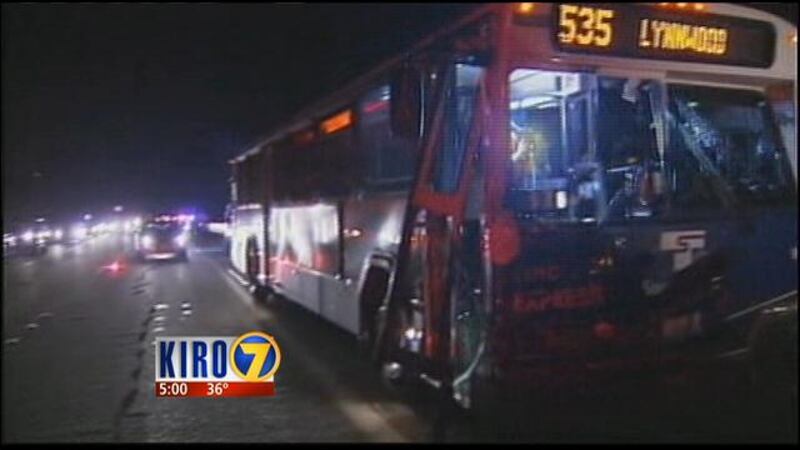KIRKLAND, Wash. — The King County Prosecutor’s Office said that there is insufficient evidence to file vehicular homicide charges against a Sound Transit bus driver who caused a collision that killed two people in Kirkland last year.
The crash occurred on May 6, 2013, when a Sound Transit bus failed to stop for a red light after exiting a freeway exit ramp.
The bus traveled through an intersection and hit with a Ford Escape. Two passengers in the Ford, Robert and Elizabeth Rotta, were killed. Their son, Kendall Rotta, was injured.
After the collision, the bus continued forward down an onramp toward Interstate 405. The bus driver, Aleksandr Rukhlin, 56, told one passenger that he “has no brakes.”
Investigators determined there was no mechanical issue with the bus or the brakes, and an examination of computers on the bus showed Rukhlin accelerated before and after the crash.
There was no evidence that Rukhlin was under the influence of drugs or alcohol.
The King County Prosecutor’s Office’s explanation of why Ruhklin cannot be charged follows:
Since there is no evidence of impairment, prosecutors reviewed the case for potential vehicular homicide charges based upon whether Rukhlin was driving in a reckless manner or with Disregard for the Safety of Others (DSO). Reckless manner requires proof that the defendant was driving "in a rash or heedless manner, indifferent to the consequences." Reckless manner is described as knowingly dangerous driving that is seen when drivers are purposely weaving and/or speeding away from police or racing with other drivers or purposefully ignoring traffic signals and signs while engaging in other dangerous driving behavior.
In the present case, there is no evidence that Rukhlin intended to go through the red light, or otherwise acted in a rash or heedless manner. Under these circumstances, the evidence is insufficient to support the reckless manner prong.
The other element in a vehicular homicide case is Disregard for the Safety of Others (DSO). The Washington Supreme Court has held that driving with disregard for the safety of others means driving with "an aggravated kind of negligence or carelessness, falling short of recklessness but constituting a more serious dereliction than the hundreds of minor oversights and inadvertences encompassed within the term 'negligence.'" Accordingly, to prove DSO, the State must show negligence plus some level of conscious disregard of a dangerous or a potentially dangerous situation.
The fact that a driver is negligent, even when it causes the death of another is not sufficient to establish vehicular homicide. See State v. Gostol, 92 Wn. App. 832 (1998); State v. Thompson, 90 Wn. App. 41 (1998); State v. Rogers, 70 Wn. App. 626 (1993). "Every violation of a positive statute, from a defective taillight to an inaudible horn may constitute negligence under the motor vehicle statutes, yet be unintentional, committed without knowledge, and amount to no more than oversight or inadvertence. . .To drive with disregard for the safety of others, consequently, is a greater and more marked dereliction than ordinary negligence." State v. Eike, 72 Wn.2d 760 (1967).
In the present case, Rukhlin's driving was certainly negligent, but the State cannot prove beyond a reasonable doubt that the negligence was aggravated, i.e., that Rukhlin consciously disregarded a dangerous situation. Despite a thorough investigation, the reasons for Rukhlin's driving through the red light remain uncertain.
There is no evidence that Rukhlin was deliberately attempting to run the light. There is no evidence that prior to the collision that he was aware that his speed was unusually fast or he was intentionally speeding. The evidence appears to support pedal misapplication without any contributing factors and that alone is negligence, but does not rise to DSO.
The case was also submitted for review of a felony hit and run charge as the bus did not stop for nearly ¾ of a mile after the collision. The elements of hit and run require that the State prove a driver knew he was involved in a crash and failed to immediately carry out certain required duties, e.g, remain at the scene and give police information. It is clear that Rukhlin knew he was involved in the collision. Immediately after the collision, he claimed that he could not get the bus to stop, and, with the assistance of the passenger, he was able to stop the bus. Given that there is no evidence that Rukhlin was actually attempting to flee from the scene, hit and run charges cannot be filed. The case will be forwarded to King County District Court for the filing of infractions.
Want to talk about the news of the day? Watch free streaming video on the KIRO 7 mobile app and iPad app, and join us here on Facebook.
KIRO








